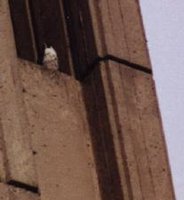
He's actually 15" long with a 40" wingspan
Over the summer it has been our great privilege to witness the comings and goings of a rare peregrine falcon. He favors the top left `shelf' of the Sciences Library, whence he regally surveys the campus looking for food. Sometimes he has his back to us and appears to be resting (with a 200-foot drop behind him); sometimes he's facing out, grooming and on the look-out.
Peregrines prey almost exclusively on birds--you may have noticed a reduction in the pigeon population lately! There are certainly very few visible from my office on the 4th floor and the appearance of various wings, viscera and non-delectable body parts on CIT decks attest to his being well fed. We believe he is the offspring of a pair of falcons who were seen and heard calling and flying between the two buildings and around the SciLi several weeks ago. The parents haven't been seen lately, but the juvenile (or is it the adult male?) hangs out daily on the CIT side, where he can be viewed from the 5th-floor deck. He's so high up that binoculars are necessary for a decent view (and you'll still get a cricked neck from looking up).
In July, the ProJo ran an article about peregrines nesting in a high- rise downtown; perhaps this one is from that family. Peregrines became endangered when they absorbed DDT, which their prey had ingested. This caused females to produce eggs with very weak breakable shells. In the '70s falcons were raised in captivity to rebuild the natural population. So it's really thrilling to be this close to such a magnificent creature.
PS This afternoon there were TWO peregrines on the SciLi!
